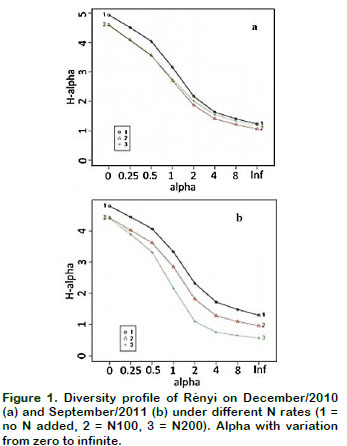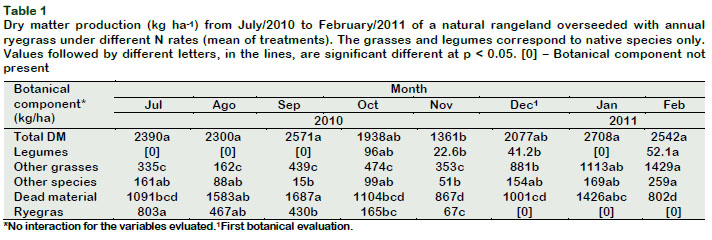Servicios Personalizados
Revista
Articulo
Indicadores
-
 Citado por SciELO
Citado por SciELO
Links relacionados
-
 Similares en
SciELO
Similares en
SciELO
Compartir
Scientia Agropecuaria
versión impresa ISSN 2077-9917
Scientia Agropecuaria vol.10 no.2 Trujillo abr./jun. 2019
http://dx.doi.org/10.17268/sci.agropecu.2019.02.16
SHORT COMMUNICATION
Botanical composition of a natural rangeland overseeded with annual ryegrass under N fertilization
Ávila, M.R.1,*; Nabinger, C.2; Schneider-Canny, R.3; Fedrigo, J.K.4 ORCID iD: http://orcid.org/0000-0003-4472-453X
1 Universidade Federal do Pampa, Dom Pedrito, RS, Brazil.
2 Universidade Federal do Rio Grande do Sul, Porto Alegre, RS, Brazil.
3 Noble Research Institute, Oklahoma, EUA.
4 Universidad de la República Oriental del Uruguay, Melo, Carro Largo, Uruguay.
Abstract
The fertilization in rangelands has a positive effect in the forage production. The increased nitrogen (N) availability improves plant growth and forage quality of native pastures. However, in the Pampa biome conditions of Rio Grande do Sul State, Brazil, these responses occur surprisingly fast and consistently. Therefore, the objective of this work was to quantify the N effect in the botanical composition of a natural pasture overseeded with annual ryegrass in Southern Brazil. The effects of three rates of N fertilization (zero, 100 and 200 kg N ha-1) were evaluated. Forage biomass was estimated on a monthly basis using the double sampling approach. The different botanical components of each forage sample were manually sorted in the laboratory. In order to calculate the Rényi diversity profile, two floristic composition evaluations were performed in the experimental area in December of 2010 and September of 2011. The ryegrass biomass production is highly affected by the N fertilization. The botanical composition of natural pastures modifies most probably by increasing ryegrass competition at early spring.
Keywords: Rangeland fertilization; nitrogen; annual ryegrass; biomass.
1. Introduction
In Rio Grande do Sul, the most Southern Brazilian State, the meat production occurs mostly in the natural rangelands of the Pampa biome (Allen et al., 2011). The Pampa biome is one of the six biomes found in Brazil and extends to Argentina and Uruguay (Pereira et al., 2018). Nitrogen (N) fertilization has a positive effect on the natural rangelands productivity (Sanderson et al., 1997) since higher N availability improves biomass production as well as the crude protein levels of the pasture.
Despite the increased interest in understanding the impacts of the management practices used in the natural rangelands (Storkey et al., 2015; Jaurena et al., 2016), there is a lack of information about the effects of long term fertilization and the practice of overseeding the rangelands with exotic species.
A few years are necessary to clearly notice the effects of fertilization on rangelands specially on the modification of the botanical composition (Hughes and Metcalfe, 1972). However, in the environmental conditions of the Pampa biome in Rio Grande do Sul the effects of fertilization have been occurring surprisingly fast and consistantly (Boggiano et al., 2000). Therefore, the objetive of this work is to quantify the effect of N fertilization in the botanical composition in a the natural rangeland pasture overseeded with annual ryegrass located in the Depressao Central region in the state of de Rio Grande do Sul, Brazil.
2. Materials and methods
The work was conducted in an area of natural rangeland (30°05’52" S, 51°39’08" W) with deep and well drained soil. During the period of study, annual ryegrass was overseeded on 05/27/2010 and 04/13/2011 at the rate of 46 kg seeds ha-1.
The treatments consisted of two rates of N, as urea, one with 100 kg N ha-1 (N100) and one with 200 kg N ha-1 (N200) and, the control area with no fertilization. The biomass offer was mantained at 12% (12 Kg of dry biomass 100 kg-1 livestock ha-1) using young heifers cross breed of Angus-Hereford-Nelore. To estimate the biomass production, as dry matter (DM), we utilized the double-sample method (Wilm et al., 1944). The biomass samples collected at the field were taken to the lab for manual classification of the botanical components: ryegrass, other grasses, legumes, other species, and dead material. Following, the samples were weighed and placed to dry in forced air oven at 60 ºC t determine the dry matter.
To calculate the diversity profiles of Rényi two botanical evaluations (number of differents species) were carried out on December/2010 and September/2011. The data for DM and botanical components were submited to estatistical analysis using PROC MIXED (mix models) of SAS 9.0. The diversity profiles of Rényi were calculated to compare the effects of the N rates on the richness of the botanical diversity using the statistical software R.
3. Results and discussion
On September, the control treatment (no N added) generated higher diversity of species, obtaining 1,9874 in the diversity profile of Rényi. While the treatment N100 had 1.4302 and 1 N200 obtained 1.4806. The treatments N100 and N200 clearly demonstrate a reduced diversity, mainly on N200 (Figure 1). During this period, the annual ryegrass was the predominant species on the fertilized treatments (Table 1). The ryegrasss dominance was determinant for the reduction of species diversity. In both treatments with N fertilization there is the tendency to de-crease diversity, which results in a strong effect on the ecosystem (Chapin et al., 1997).
The diversity of species according to the Rényi index shows that on December (Figure 1a) the treatment with no N added obtained higher diversity and uniformity of species (Control = 1.8433, N100 = 1.3941, N200 = 1.3160). As the amount of each species present in the rangeland changes, so that there is less equality, the curve will tend to be more inclined with more variability in the values (Hill, 1973).
There was a significant difference between the evaluation months for the biomass of the legumes, other grasses, other species, annual raygrass and dead material (Table 1), however, the N fertilization had a significant effect only on the raygrass. For the raygrass a significant difference was observed for the period of evaluation (p ≤ 0.0001) and treatment (p = 0.0016) (Ávila et al., 2013).
There was a significant reduction on the biomass production of the legumes and other grasses, from the first evaluation (December, 2010) compared to the last evaluation (February, 2011).
However, the N effect was significant only for the biomass production of the annual ryegrass, that had a higher production on july (2010).
4. Conclusions
The biomass production of ryegrass is highly dependent on the N rate. The botanical composition of the natural rangeland overseeded with ryegrass was modified by the increased increments of N fertilization.
According to the diversity profiles of Rényi the highest diversity and uniformity of species occurred in the control treatment where no N was added.
Acknowledgments
The assistance of Mr. Adebowale Olabanji of Bridge-Biotech Ltd, Ilorin, Nigeria is gratefully recognised.
References
Ávila, M.R.A.; Nabinger, C.; Brambilla, D.M.; Carassai, I.J; Kunrath, TR. 2013. The effects of nitrogen enrichment on tiller population density and demographics of annual ryegrass overseeded on natural pastures South of Brazil. African Journal of Agricultural Research 8(23): 3013-3018. [ Links ]
Allen, V.G.; Batello, C.; Berretta, E.J.; Hodgson, J.; Kothmann M.; Li X. et al. 2011. An international terminology for grazing lands and grazing animals. Grass and Forage Science 66: 2-28. [ Links ]
Boggiano, P.R.; Marachin, G.E.; Nabinger, C. et al. 2000. Efeito da adubação nitrogenada e oferta de forragem sobre a carga animal, produção e utilização da matéria seca numa pastagem nativa do Rio Grande do Sul. In: Proceedings of 37 Reunião da Sociedade Brasileira de Zootecnia. SBZ, Viçosa, MG. [ Links ]
Chapin, F.S.; Walker, B.H.; Hobbs, R.J.; Hooper, D.U.; Lawton, J.H.; Sala, O.E.; Tilman, D. 1997. Biotic control over the functioning of ecosystems. Science 277(5325), 500-504. [ Links ]
Hill, M.O. 1973. Diversity and evenness: a unifying notation and its consequences. Ecology 54: 427-473. [ Links ]
Hughes, H.D.; Metcalfe, D.S. 1972. Pasture and pasture improvement. In: Crop Production (eds. Hughes DT & Metcalfe DS). MacMillan: New York, pp. 225-241. [ Links ]
Jaurena, M.; Lezama, F.; Salvo, L.; Cardozo, G.; Ayala, T.J.; Nabinger, G. 2016. The Dilemma of Improving Native Grasslands by Overseeding Legumes: Production Intensification or Diversity Conservation. Rangeland Ecology & Management 69: 35-42. [ Links ]
Pereira, C.H; Patino, O.P.; Hoshideb, A.K.; Abreu, D.C.; Rotz, A.; Nabinger, C. 2018. Grazing supplementation and crop diversification benefits for southern Brazil beef: A case study. Agricultural Systems 162: 1-9. [ Links ]
Sanderson, M.A.; Stair, D.W.; Hussey, M.A. 1997. Physiological and morphological responses of perennial forages to stress. Advances in Agronomy, San Diego 59: 171-224. [ Links ]
Storkey, J.; Macdonald, AJ.; Poulton, PR.; Scott, T; Köhler, IH.; Schnyder, H.; Goulding, K.W.T.; Crawley, J. 2015. Grassland biodiversity bounces back from long-term nitrogen addition. Nature 528: 401-404. [ Links ]
Wilm, H.G.; Costello, D.F.; Klipple, G.E. 1944. Estimating forage yield by the double sampling method. Journal of American Society of Agronomy 36: 194-203. [ Links ]
* Corresponding author
E-mail: marianaravila@gmail.com (M. Ávila).
Received February 11, 2019.
Accepted March 17, 2019.
















